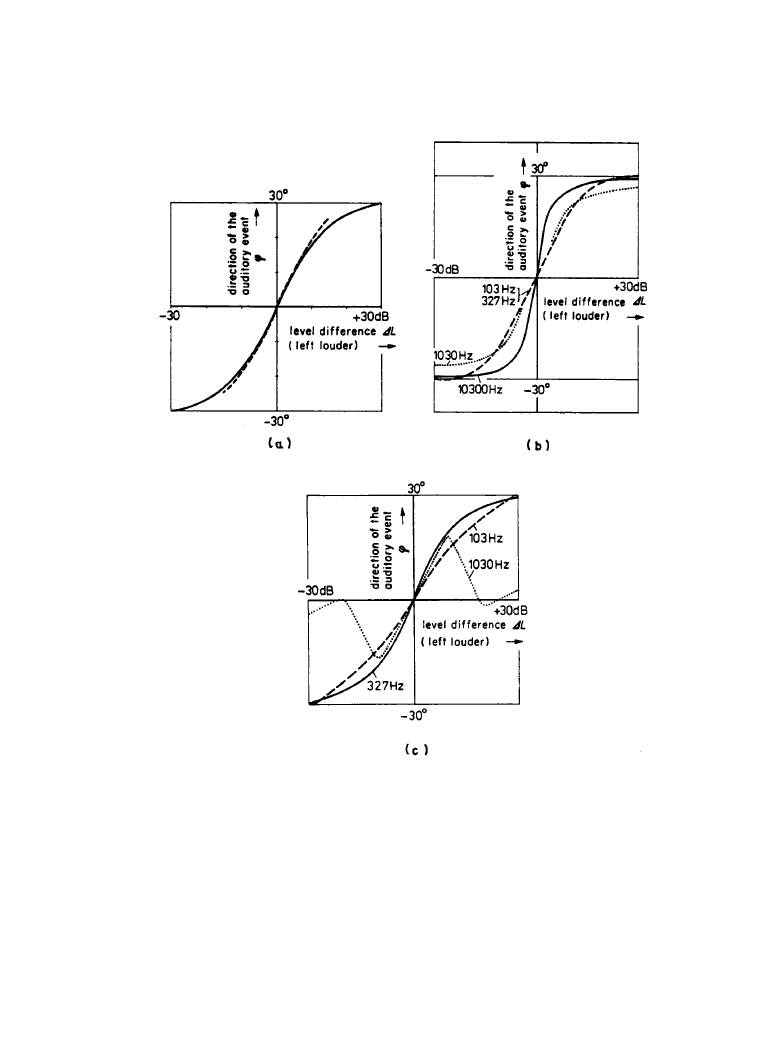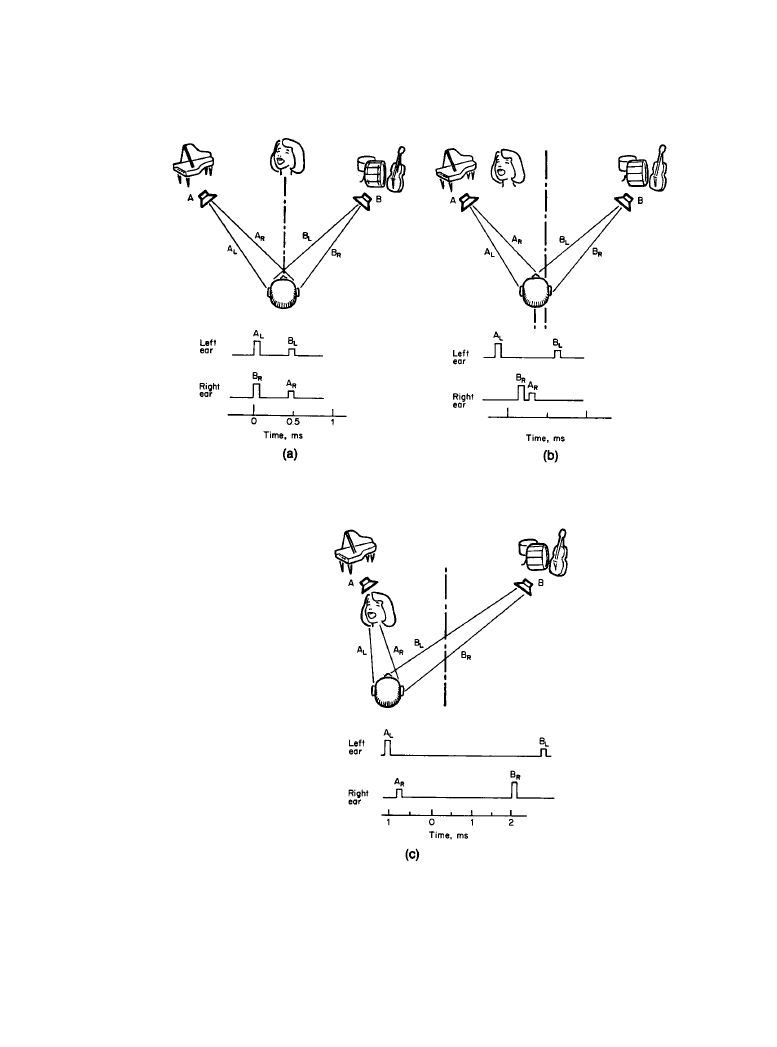ВУЗ: Казахская Национальная Академия Искусств им. Т. Жургенова
Категория: Книга
Дисциплина: Не указана
Добавлен: 03.02.2019
Просмотров: 21586
Скачиваний: 19

1-66 Principles of Sound and Hearing
speakers, and it can be seen that an interchannel time difference is perceived as an ITD. At larger
values of interchannel time difference the first arrivals are from the same loudspeaker, and the
dominant auditory image remains at that location. This is because of the law of the first wave-
front, also known as the precedence effect, according to which the dominant auditory event is
perceived to be coincident with the loudspeaker radiating the earlier sound. The other sound
components are still there nonetheless, and they can contribute to complexity in the spatial illu-
sion as well as to changes in timbre.
With amplitude differences (also known as intensity stereo), the temporal pattern of events in
the two ears is unchanged until the difference approaches infinity. At this point, the ears receive
signals appropriate to a simple sound source with the attendant sound and localization accuracy.
It is a real (monophonic) sound source generating a correspondingly real auditory event.
1.4.3k
Summing Localization with Interchannel Time and Amplitude Differences
Figure 1.4.13 shows the position of the auditory image as a function of interchannel time differ-
ence for the conventional stereophonic listening situation shown in Figure 1.4.11. The curves
shown are but a few of the many that are possible since, as is apparent, the trajectory of the audi-
tory image is strongly influenced by signal type and spectral composition.
In contrast, the curves in Figure 1.4.14, showing the position of the auditory image as a func-
tion of interchannel amplitude difference, are somewhat more orderly. Even so, there are signifi-
cant differences in the slopes of the curves for different signals.
With a signal like music that is complex in all respects, it is to be expected that, at a fixed time
or amplitude difference, the auditory event will not always be spatially well defined or position-
ally stable. There are situations where experienced listeners can sometimes identify and indepen-
dently localize several coexisting auditory images. Generally, however, listeners are inclined to
respond with a single compromise localization, representing either the “center of gravity” of a
spatially complex image display or the dominant component of the array. If the spatial display is
ambiguous, there can be a strong flywheel effect in which occasional clear spatial indications
from specific components of the sound engender the perception that all of that sound is continu-
ously originating from a specific region of space. This is especially noticeable with the onset of
transient or any small mechanical sounds that are easily localized compared with the sustained
portion of the sounds.
The blur in stereo localization, as in natural localizaton, is least for an image localized in the
forward direction, where, depending on the type of sound, the stereo localization blur is typically
about 3 to 7°. With the image fully displaced by amplitude difference (IAD = 30 dB), the blur
increases to typical values of 5 to 11°. With the image fully displaced by means of time differ-
ence (ITD = 1 ms), the blur increases to typical values of 10 to 16° [17].
Effect of Listener Position
Sitting away from the line of symmetry between the speakers causes the central auditory images
to be displaced toward the nearer loudspeaker. Interaural time differences between the sound
arrivals at the ears are introduced as the path lengths from the two speakers change. Within the
first several inches of movement away from the axis of symmetry, the sound components from
the left and right loudspeakers remain the first arrivals at the respective ears. In this narrow
region it is possible to compensate for the effect of the ITD by adding the appropriate opposite
bias of interchannel amplitude difference (see Figure 1.4.15). This process is known as time-
Downloaded from Digital Engineering Library @ McGraw-Hill (www.digitalengineeringlibrary.com)
Copyright © 2004 The McGraw-Hill Companies. All rights reserved.
Any use is subject to the Terms of Use as given at the website.
The Physical Nature of Hearing

The Physical Nature of Hearing 1-67
intensity trading, and it is the justification for the balance control on home stereo systems, sup-
posedly allowing the listener to sit off the axis of symmetry and to compensate for it by introduc-
ing an interchannel amplitude bias. There are some problems, however, the first one being that
the trading ratio is different for different sounds, so that the centering compensations do not work
Figure 1.4.13
Direction of auditory images perceived by a listener in the situation of Figure 1.4.11
when the interchannel time difference is varied from 0 to +1 ms (left channel earlier) and –1 ms
(right channel earlier). The curves show the results using different sounds: (
a) dashed line =
speech, solid line = impulses; (
b) tone bursts; (c) continuous tones. (From [17]. Used with permis-
sion.)
Downloaded from Digital Engineering Library @ McGraw-Hill (www.digitalengineeringlibrary.com)
Copyright © 2004 The McGraw-Hill Companies. All rights reserved.
Any use is subject to the Terms of Use as given at the website.
The Physical Nature of Hearing

1-68 Principles of Sound and Hearing
equally for all components of a complex signal; the image becomes blurred. The second problem
arises when the listener moves beyond the limited range discussed previously, the simple form of
summing localization breaks down, and the more complicated precedence effect comes into
effect. In this region, it is to be expected that the auditory image will become rather muddled,
Figure 1.4.14
Direction of auditory images perceived by a listener in the situation of Figure 1.4.11
when the interchannel amplitude difference is varied from 0 to +30 dB (left louder) and –30 dB
(right louder). The curves show the results with different sounds: (
a) dashed line = speech, solid
line = impulses; (
b) tone bursts; (c) continuous tones. (From [17]. Used with permission.)
Downloaded from Digital Engineering Library @ McGraw-Hill (www.digitalengineeringlibrary.com)
Copyright © 2004 The McGraw-Hill Companies. All rights reserved.
Any use is subject to the Terms of Use as given at the website.
The Physical Nature of Hearing

The Physical Nature of Hearing 1-69
Figure 1.4.15
Sequence of events as a listener moves progressively away from the axis of sym-
metry in stereophonic listening.
Downloaded from Digital Engineering Library @ McGraw-Hill (www.digitalengineeringlibrary.com)
Copyright © 2004 The McGraw-Hill Companies. All rights reserved.
Any use is subject to the Terms of Use as given at the website.
The Physical Nature of Hearing

1-70 Principles of Sound and Hearing
increasing in size and spaciousness. Localization will tend to be related to the center of gravity of
a spatially diffuse auditory event rather than of a specific compact event. Nevertheless, in record-
ings of ensembles with natural ambience the trading may be judged to be satisfactory, since the
initial effect is, by design, rather diffuse. As the listener moves about, there will also be progres-
sive changes to the timbre due to the directional properties of the loudspeakers and wave interfer-
ence between essentially similar sounds arriving at the ears with various time delays.
Stereo Image Quality and Spaciousness
The position of auditory events is but a part of the total spatial impression. In stereo reproduction
as in live performances, listeners appreciate the aspect of spaciousness as long as it creates a
realistic impression. The process by which an impression of spaciousness is generated in stereo
is much the same as in normal hearing—a reduction in interaural cross correlation. The tradeoff
is also similar, in that as the feeling of space increases, the width of the auditory images also
increases [33]. The extent to which the interchannel cross-correlation coefficient is altered to
manipulate these effects is, therefore, a matter of artistic judgment depending on the type of
music involved.
Special Role of the Loudspeakers
In the production of stereophonic recordings the impressions of image position, size, and spa-
ciousness are controlled by manipulating the two-channel signals. However, the impressions
received by the listener are also affected by the loudspeakers used for reproduction and their
interaction with the listening room.
The directionality of the loudspeakers and the location of reflecting room boundaries together
determine the relative strengths of the direct, early-reflected, and reverberant sounds that
impinge on the listener. To the extent that the reflected sounds can reduce the correlation
between the sounds at the two ears, it is clear that loudspeakers with substantial off-axis sound
radiation can enhance the sense of spaciousness. For this to be effective, however, the listening
room boundaries must be sound-reflecting at least at the points of the first reflections, especially
the wall (lateral) reflections.
There is evidence that listeners in domestic situations prefer a certain amount of locally gen-
erated spaciousness [19, 34, 35]. In part this may be due to the more natural spatial distribution
of the reflected sounds in the listening room as opposed to the recorded ambient sounds which
are reproduced only as direct sounds from the loudspeakers. Loudspeakers placed in a room
where the early reflections have been absorbed or directional loudspeakers placed in any type of
room would be expected to yield a reproduction lacking spaciousness. This, it seems, is preferred
by some listeners at home and many audio professionals in the control room [35, 36] especially
with popular music. The fact that opinions are influenced by the type of music, individual prefer-
ences, and whether the listening is done for production or for pleasure makes this a matter for
careful consideration. Once selected, the loudspeaker and the room tend to remain as fixed ele-
ments in a listening situation.
Downloaded from Digital Engineering Library @ McGraw-Hill (www.digitalengineeringlibrary.com)
Copyright © 2004 The McGraw-Hill Companies. All rights reserved.
Any use is subject to the Terms of Use as given at the website.
The Physical Nature of Hearing